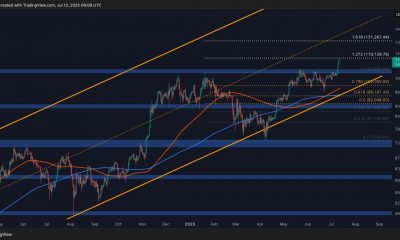Commodities
Energy & precious metals – weekly review and outlook


© Reuters.
Investing.com — With just a week symbolically left for the peak of summer driving, most Americans must be relieved that they survived not just the road but also prices at the pump.
Despite fears when the warm season began three months ago that we’ll go back to last summer’s gasoline record of $5 a gallon, Thursday’s weekly round-up of pump prices across the United States showed the national average at $3.82 a gallon, down 5 cents from the year-ago level of $3.87.
The previous week’s average was also $3.87 a gallon, meaning a similar discount week-on-week.
In fact, the retail price of gasoline was only higher when compared with a month ago, when it was about 13 cents more than the late-July average of $3.68.
But it isn’t time yet to wave the checkered flag on gasoline prices because the race isn’t quite over. That’s right: Drivers, don’t take a victory lap now because the American Automobile Association, or AAA, warns that prices could still spike in the near future as the North Atlantic storm season gets more intense over the Gulf Coast of Mexico where the backbone of oil production, refining and piping is located.
“Although the national average did a U-turn this week, the road ahead could lead to higher prices,” AAA spokesperson Andrew Gross wrote on a blog posted on the association’s website on Thursday. “Ongoing concerns regarding potential storm activity could hinder falling pump prices this fall.”
Despite growing demand for gasoline, the decline in the U.S. crude price from an early August high of almost $85 per barrel to below $80 now has managed to keep a lid on gasoline at the pump as well, Gross noted.
But that could change soon with the approach of the Sept. 4 Labor Day holiday, which unofficially marks the end of summer road trips in the United States.
“Gas demand and volatile oil prices, particularly during an active hurricane season, could limit how much lower prices descend in the weeks ahead,” AAA said on its website.
The National Oceanic and Atmospheric Administration, or NOAA, which flags all major weather changes in the United States, said what was initially known as Tropical Storm Franklin has strengthened into a Category 1 hurricane in the Atlantic — becoming the first major for this season. Franklin could gain further intensity by Sunday though its track is expected to largely avoid energy installations in the U.S. Gulf.
“While Hurricane Franklin is not expected to hit the U.S. mainland, big swells are expected to impact the Eastern Seaboard starting as early as Monday and lingering through Labor Day weekend,” the NOAA said.
It said Tropical Depression Ten was expected to bring gusty winds to Northeastern Mexico and “likely to become a hurricane over the Eastern Gulf of Mexico in a few days”.
Another wind system called Tropical Depression Ten-E was developing but is “expected to be no threat to land”, the NOAA said.
Although the 2022 season was destructive and deadly, its impact on the offshore oil industry – specifically offshore workers – was relatively mild in comparison to previous years.
A total of 17 hurricanes were recorded during the 2022 season, with three of them – Ian, Nicole and Fiona – bringing extensive damage to Florida’s coast and to Puerto Rico.
Ian was the sole storm of the 2022 Atlantic hurricane season to significantly disrupt offshore oil production in the Gulf of Mexico. About 11% of production in the Gulf was shut-in by September 27 in preparation for the storm, which hit the area as a category 4 hurricane.
Oil companies evacuated personnel from 14 platforms and rigs in anticipation of the storm, and approximately 190,000 barrels of oil per day in production were lost as a result of the disruption.
Tankers and vessels also cleared the eastern region of the Gulf of Mexico.
These measures meant that, although production was affected, no crew members were reported lost or injured as a result of Hurricane Ian or any other named storm in 2022.
This is a far cry from 2021, when the crew of the Noble-owned and Shell-leased drillship, Globetrotter II, was left to weather Hurricane Ida. Her crew of 142 were tossed about, believing they were going to capsize and sink, as 150-mph winds and 80-foot waves battered the vessel. The Coast Guard was able to rescue all of the crew members, but not before they suffered significant mental and physical trauma.
In 2020, Hurricane Zeta nearly claimed another rig, Transocean’s Deepwater Asgard.
For the record, hurricanes haven’t left too much of a toll on the U.S. oil industry over the past three years. With Mother Nature’s will, this year won’t be an exception.
Oil: Market Settlements and Activity
Crude prices rose for a second day in a row on Friday. But the gains weren’t enough to offset losses from earlier in the week. That left the market in the red for a second consecutive week amid signs the Federal Reserve wasn’t done with yet to bring U.S. inflation under control.
New York-traded , or WTI, crude did a final trade of $80.05 per barrel after officially settling Friday’s trade at $79.83 – up 78 cents, or 1%.
Despite the rebound on the day, the U.S. crude benchmark finished the week down 1.7%, after shedding 2.3% last week. Prior to that, it rose for seven straight weeks in a rally that lifted WTI by nearly 20%.
London-traded did a final trade of $84.88 after officially settling Friday’s session at $84.48 – up $1.12, or 1.3%.
Compared with WTI, Brent’s current week loss was far more modest at just 0.4%, adding to the previous week’s 2.3% drop. Before that, the global crude benchmark also rose for seven weeks in a row, rising by a total of 18%.
Oil: WTI Technical Outlook
With U.S. job numbers for August landing on the coming Friday, this week could see additional volatility in oil as macroeconomic concerns cloud a market already facing uncertainty from weak Chinese demand and the fading of the initial bull fervor over Saudi and Russian production cuts.
Technically, the bearish momentum in WTI continued for a second straight week, to below the daily Middle Bollinger Band of $81.30, while the 50-day EMA, or Exponential Moving Average, provided support at $78, noted Sunil Kumar Dixit, chief technical strategist at SKCharting.com.
For the coming week, a break below the horizontal support base of $77.60 increases the chance for WTI’s further decline to the 200-day SMA of $75.90. This support will be closely followed by the 100-day SMA of $75.20, which tends to distance WTI away the from 200-day SMA.
For the upside, WTI would have to reclaim the daily Middle Bollinger Band of $81.30, with a day closing above that mark, Dixit said, adding that this would then extend towards the previous week’s high of $82.50.
Above this, $83.20 would be a minor hurdle before the critical barriers in the form of the 100-week SMA, or Simple Moving Average, of $85.75 and the monthly middle Bollinger Band of $86.75
“In summary, short-term resistance for the week may be at $81.25, while support is seen at $78.25,” Dixit added.
Gold: Market Settlements and Activity
For a second week in a row, gold saw anemic activity as market participants took in their strides the Fed’s caution that it will likely resort to more rate hikes to get U.S. inflation back down to 2% per annum from the current 3%.
Gold futures’ most-active on New York’s Comex did a final trade of $1,943.30 per ounce after officially settling Friday’s session at $1,939.990 – down $7.20, or 0.4%
, which tracks real-time physical dealings in bullion and is more closely followed than futures by some gold traders, settled at $1,914.60, down $2.12 or 0.1%.
Gold: Bullion Technical Outlook
A break below $1,908 will force spot gold to retest the $1,900 support, under which immediate support stands at $1,885, said SKCharting’s Dixit.
“For now, the major downside potential for spot gold is seen at $1,850,” he said.
On the flip side, clearing through the $1,930 barrier will extend gold’s upward move towards the next leg higher, which is the descending weekly Middle Bollinger Band of $1,950, Dixit said.
“This zone can act as a turning point for spot gold,” he added.
Natural gas: Market Settlements and Activity
The gas contract on the New York Mercantile Exchange’s Henry Hub did a final trade of $2.552 per mmBtu, million metric British thermal units, after officially settling Friday’s session at $2.657, up 2.1 cents on the day or 0.8%.
For the week, the October gas contract slid by 0.4%.
Natural gas had an uneventful week despite of the commodity growing by just 18 billion cubic feet, or bcf, last week versus a forecast 33 bcf and a previous weekly build of 35 bcf. Analysts said concerns about approaching fall weather and gas inventories stubbornly remaining at 20% above year-ago levels had prevented the market from rallying.
Natural gas: Price Outlook
The sideways action in natural gas is supported by stability at above $2.47, which is a horizontal support base formed by long consolidation above the 100-day SMA that’s closely aligned with the weekly Middle Bollinger Band, said Dixit of SKCharting.
“As it stands, the daily 50 EMA of $2.60, followed by the daily Middle Bollinger Band of $2.64, are immediate resistance zones,” said Dixit. “If these levels are breached, major resistance will shift to the 200-day SMA, dynamically positioned at $3.10.”
Disclaimer: Barani Krishnan does not hold positions in the commodities and securities he writes about.
Commodities
Oil prices rise; U.S. crude inventories plunge, Russia-Ukraine truce eyed
Commodities
India’s Reliance to stop buying Venezuelan oil over US tariffs, sources say
Commodities
Oil prices climb on Venezuela supply worries

 Forex3 years ago
Forex3 years agoForex Today: the dollar is gaining strength amid gloomy sentiment at the start of the Fed’s week

 Forex3 years ago
Forex3 years agoUnbiased review of Pocket Option broker

 Forex3 years ago
Forex3 years agoDollar to pound sterling exchange rate today: Pound plummeted to its lowest since 1985

 Forex3 years ago
Forex3 years agoHow is the Australian dollar doing today?

 Cryptocurrency3 years ago
Cryptocurrency3 years agoWhat happened in the crypto market – current events today

 World3 years ago
World3 years agoWhy are modern video games an art form?

 Commodities3 years ago
Commodities3 years agoCopper continues to fall in price on expectations of lower demand in China

 Economy3 years ago
Economy3 years agoCrude oil tankers double in price due to EU anti-Russian sanctions





























